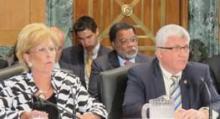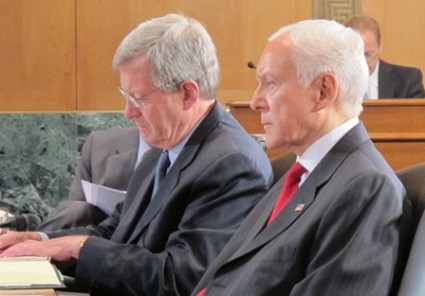User login
Congress needs to act soon to avert a scheduled 27% cut in physicians’ Medicare pay – and find a way to fix the failed system that calls for that cut – but, increasingly, experts say that the solution must be multipronged and adaptable to a variety of practice situations.
One reason that the current system has failed is that it holds individual physicians responsible for group behavior at a national level, according to Dr. Barbara Levy, vice president for health policy at the American College of Obstetricians and Gynecologists. Instead of leading to lower health costs, it actually increases them because the payment system drives physicians to increase their volume to make up for low reimbursement.
The Sustainable Growth Rate (SGR) formula – the mechanism that ties doctor pay to the gross domestic product in an effort to control costs – "was never really useful in terms of accomplishing the goal to bend the cost curve," Dr. Levy said.
Potential alternatives being evaluated provide an opportunity to get the incentives right, she said, and gear the system toward individual, not group, accountability. Payment models, however, will all need to be carefully studied over multiple years, she said, to know for sure if they will work. For instance, good preventive care is expensive in the short term but saves money over time. Looking at just 6 months of data is not enough to see if savings are possible, she said.
Legislation Offers Permanent Fix
One proposal favored by many physicians comes from Rep. Allyson Schwartz (D-Pa.) and Rep. Joe Heck (R-Nev.), an osteopathic physician. The bill (H.R. 5707) would permanently eliminate the SGR and set up a 10-year path to a new payment system.
During the initial years, physicians would receive small pay increases while Medicare officials tested new payment models, with primary care doctors getting slightly more during the transition.
After testing, physicians could choose from among a menu of alternative payment and delivery options. Those who didn’t participate in one of the new quality-based models would see their fee-for-service payments reduced starting in 2019.
Rep. Schwartz said there is an "outside hope" that the bill could be considered during the lame-duck session that follows the Nov. 6 election. If not then, it could come up in early 2013.
Overall, she said that she’s encouraged by the increasing agreement between physicians and lawmakers to move toward innovative payment models.
She advised doctors to keep talking to their members of Congress about the need to adopt a new system that pays adequately for high-quality care. The more bipartisan agreement around that concept, the better, she said.
"There’s no question that physicians should be looking at ways they can participate in new payment models," Rep. Schwartz said.
The House and Senate committees that oversee Medicare – the Senate Finance Committee, the House Energy and Commerce Committee, and the House Ways and Means Committee – also have been talking to physicians and insurers about what type of payment system could replace the SGR.
Committee members appear to be working toward legislation that would extend current Medicare payment rates temporarily while moving toward value-based payment models, according to Bob Doherty, senior vice president of governmental affairs and public policy at the American College of Physicians.
If lawmakers went forward with that type of plan, physicians would probably have the chance to earn a small pay increase for participating in programs that reward value or care coordination. That approach would still leave the SGR in place, though, at least in the short-term.
"The hope is that, as more physicians begin to move to these other models and you get more experience with them, that will create a roadmap to eventually sunsetting the entire SGR and replacing it with these value-based payment models," Mr. Doherty said.
Although the emphasis on getting away from the current system is encouraging, Mr. Doherty said he’s concerned about any approach that falls short of repealing the SGR.
Variety Is Needed
It’s also looking like a plan to replace the SGR could include a variety of payment models, not just a single alternative, said Ray Quintero, director of government relations for the American Osteopathic Association.
"A one-size-fits-all solution is no longer possible," he said. "At the end of the day, every physician practices differently, the patients that they serve are different, the services that they provide are different, and the payment models should be reflective of that."
Some of those new models may come from the Center for Medicare and Medicaid Innovation, which was created under the Affordable Care Act and is testing new ways to pay for and deliver health care, but Congress is also looking to the private health plans for solutions that have already been tested and produced savings, Mr. Quintero said.
Time to Act Is Now
Dr. William Zoghbi, president of the American College of Cardiology, said that the problem is urgent and members of Congress need to look to payments models that are ready for implementation today.
The ACC has developed SMARTCare, a program to address variation in cost and quality in the treatment of stable ischemic heart disease. SMARTCare uses registry data to help physicians employ the most appropriate diagnostics and treatments. Such a program could be used hand-in-hand with a bundled payment model, he said.
"There are so many ways of doing it, but I think we really need to get together and make some early decisions to move forward," Dr. Zoghbi said.
He called on Congress and the administration to provide leadership. Physicians want to be involved in changing the system, but they are only one piece, he said. Policymakers also need to work with drug and device companies and hospitals to cut back on waste and make the health care system more sustainable.
"The further we delay these decisions, the more costly it is," Dr. Zoghbi said.
Gail Wilensky, Ph.D., who ran the Medicare and Medicaid programs from 1990 to 1992, agreed.
She suggested a number of payment alternatives Congress could consider, including bundling physician payments for high-cost, high-volume interventions.
Now Congress needs to direct the Centers for Medicare and Medicaid Services or the Medicare Payment Advisory Commission to come up with a plan and give them a firm deadline, she said. With that plan in hand, it would be easier for members of Congress to justify spending $300 billion to replace the SGR system.
"Until they do that, you don’t have anything to talk about," said Dr. Wilensky, who is currently an economist and senior fellow at Project HOPE.
Physicians can do their part to speed the legislative heavy lifting by presenting concrete alternatives with a real capacity to cut costs for the health care system, said Dr. Mark B. McClellan, who was the CMS administrator from 2004 to 2006 and is now director of the Engelberg Center for Health Care Reform at the Brookings Institution.
He cited some of the medical-home models that have been implemented by private health plans as good examples. These medical homes provide substantially better up-front payments for primary care physicians but also make physicians accountable for keeping overall costs down.
"Leadership on this is going to have to come from physicians and physician organizations," Dr. McClellan said. "Congress and the Medicare program are under a lot of pressure to do more to balance the budget, to do more to keep costs down while keeping quality up. They don’t have the best ideas. Physicians do."
Dealing with the Status Quo
Although most physicians don’t believe that Congress will allow large cuts to physician payment to go into effect, it’s possible that the trend of enacting temporary payment patches could continue for a few years.
If the status quo persists, it would make it increasingly difficult for physicians to plan their expenses and run their offices, said Dr. Glen R. Stream, president of the American Academy of Family Physicians.
"It tests people’s willingness to continue to participate in the Medicare program," Dr. Stream said. "So often we don’t look at doctors’ offices, particularly small offices, as businesses. And yet they are businesses and they have expenses that are going up all the time as far as insurance, utilities, and staff."
More practices will critically evaluate their continued participation in Medicare, he said.
No matter what the outcome of November’s election, lawmakers will have to address the physician payment issue, Dr. Stream said. His biggest concern right now is that the election continues the partisan stalemate of the last few years.
"That stalemate in a lot of ways could actually be more harmful to evolving so many things about our health care system, including the physician payment piece," he said.
Congress needs to act soon to avert a scheduled 27% cut in physicians’ Medicare pay – and find a way to fix the failed system that calls for that cut – but, increasingly, experts say that the solution must be multipronged and adaptable to a variety of practice situations.
One reason that the current system has failed is that it holds individual physicians responsible for group behavior at a national level, according to Dr. Barbara Levy, vice president for health policy at the American College of Obstetricians and Gynecologists. Instead of leading to lower health costs, it actually increases them because the payment system drives physicians to increase their volume to make up for low reimbursement.
The Sustainable Growth Rate (SGR) formula – the mechanism that ties doctor pay to the gross domestic product in an effort to control costs – "was never really useful in terms of accomplishing the goal to bend the cost curve," Dr. Levy said.
Potential alternatives being evaluated provide an opportunity to get the incentives right, she said, and gear the system toward individual, not group, accountability. Payment models, however, will all need to be carefully studied over multiple years, she said, to know for sure if they will work. For instance, good preventive care is expensive in the short term but saves money over time. Looking at just 6 months of data is not enough to see if savings are possible, she said.
Legislation Offers Permanent Fix
One proposal favored by many physicians comes from Rep. Allyson Schwartz (D-Pa.) and Rep. Joe Heck (R-Nev.), an osteopathic physician. The bill (H.R. 5707) would permanently eliminate the SGR and set up a 10-year path to a new payment system.
During the initial years, physicians would receive small pay increases while Medicare officials tested new payment models, with primary care doctors getting slightly more during the transition.
After testing, physicians could choose from among a menu of alternative payment and delivery options. Those who didn’t participate in one of the new quality-based models would see their fee-for-service payments reduced starting in 2019.
Rep. Schwartz said there is an "outside hope" that the bill could be considered during the lame-duck session that follows the Nov. 6 election. If not then, it could come up in early 2013.
Overall, she said that she’s encouraged by the increasing agreement between physicians and lawmakers to move toward innovative payment models.
She advised doctors to keep talking to their members of Congress about the need to adopt a new system that pays adequately for high-quality care. The more bipartisan agreement around that concept, the better, she said.
"There’s no question that physicians should be looking at ways they can participate in new payment models," Rep. Schwartz said.
The House and Senate committees that oversee Medicare – the Senate Finance Committee, the House Energy and Commerce Committee, and the House Ways and Means Committee – also have been talking to physicians and insurers about what type of payment system could replace the SGR.
Committee members appear to be working toward legislation that would extend current Medicare payment rates temporarily while moving toward value-based payment models, according to Bob Doherty, senior vice president of governmental affairs and public policy at the American College of Physicians.
If lawmakers went forward with that type of plan, physicians would probably have the chance to earn a small pay increase for participating in programs that reward value or care coordination. That approach would still leave the SGR in place, though, at least in the short-term.
"The hope is that, as more physicians begin to move to these other models and you get more experience with them, that will create a roadmap to eventually sunsetting the entire SGR and replacing it with these value-based payment models," Mr. Doherty said.
Although the emphasis on getting away from the current system is encouraging, Mr. Doherty said he’s concerned about any approach that falls short of repealing the SGR.
Variety Is Needed
It’s also looking like a plan to replace the SGR could include a variety of payment models, not just a single alternative, said Ray Quintero, director of government relations for the American Osteopathic Association.
"A one-size-fits-all solution is no longer possible," he said. "At the end of the day, every physician practices differently, the patients that they serve are different, the services that they provide are different, and the payment models should be reflective of that."
Some of those new models may come from the Center for Medicare and Medicaid Innovation, which was created under the Affordable Care Act and is testing new ways to pay for and deliver health care, but Congress is also looking to the private health plans for solutions that have already been tested and produced savings, Mr. Quintero said.
Time to Act Is Now
Dr. William Zoghbi, president of the American College of Cardiology, said that the problem is urgent and members of Congress need to look to payments models that are ready for implementation today.
The ACC has developed SMARTCare, a program to address variation in cost and quality in the treatment of stable ischemic heart disease. SMARTCare uses registry data to help physicians employ the most appropriate diagnostics and treatments. Such a program could be used hand-in-hand with a bundled payment model, he said.
"There are so many ways of doing it, but I think we really need to get together and make some early decisions to move forward," Dr. Zoghbi said.
He called on Congress and the administration to provide leadership. Physicians want to be involved in changing the system, but they are only one piece, he said. Policymakers also need to work with drug and device companies and hospitals to cut back on waste and make the health care system more sustainable.
"The further we delay these decisions, the more costly it is," Dr. Zoghbi said.
Gail Wilensky, Ph.D., who ran the Medicare and Medicaid programs from 1990 to 1992, agreed.
She suggested a number of payment alternatives Congress could consider, including bundling physician payments for high-cost, high-volume interventions.
Now Congress needs to direct the Centers for Medicare and Medicaid Services or the Medicare Payment Advisory Commission to come up with a plan and give them a firm deadline, she said. With that plan in hand, it would be easier for members of Congress to justify spending $300 billion to replace the SGR system.
"Until they do that, you don’t have anything to talk about," said Dr. Wilensky, who is currently an economist and senior fellow at Project HOPE.
Physicians can do their part to speed the legislative heavy lifting by presenting concrete alternatives with a real capacity to cut costs for the health care system, said Dr. Mark B. McClellan, who was the CMS administrator from 2004 to 2006 and is now director of the Engelberg Center for Health Care Reform at the Brookings Institution.
He cited some of the medical-home models that have been implemented by private health plans as good examples. These medical homes provide substantially better up-front payments for primary care physicians but also make physicians accountable for keeping overall costs down.
"Leadership on this is going to have to come from physicians and physician organizations," Dr. McClellan said. "Congress and the Medicare program are under a lot of pressure to do more to balance the budget, to do more to keep costs down while keeping quality up. They don’t have the best ideas. Physicians do."
Dealing with the Status Quo
Although most physicians don’t believe that Congress will allow large cuts to physician payment to go into effect, it’s possible that the trend of enacting temporary payment patches could continue for a few years.
If the status quo persists, it would make it increasingly difficult for physicians to plan their expenses and run their offices, said Dr. Glen R. Stream, president of the American Academy of Family Physicians.
"It tests people’s willingness to continue to participate in the Medicare program," Dr. Stream said. "So often we don’t look at doctors’ offices, particularly small offices, as businesses. And yet they are businesses and they have expenses that are going up all the time as far as insurance, utilities, and staff."
More practices will critically evaluate their continued participation in Medicare, he said.
No matter what the outcome of November’s election, lawmakers will have to address the physician payment issue, Dr. Stream said. His biggest concern right now is that the election continues the partisan stalemate of the last few years.
"That stalemate in a lot of ways could actually be more harmful to evolving so many things about our health care system, including the physician payment piece," he said.
Congress needs to act soon to avert a scheduled 27% cut in physicians’ Medicare pay – and find a way to fix the failed system that calls for that cut – but, increasingly, experts say that the solution must be multipronged and adaptable to a variety of practice situations.
One reason that the current system has failed is that it holds individual physicians responsible for group behavior at a national level, according to Dr. Barbara Levy, vice president for health policy at the American College of Obstetricians and Gynecologists. Instead of leading to lower health costs, it actually increases them because the payment system drives physicians to increase their volume to make up for low reimbursement.
The Sustainable Growth Rate (SGR) formula – the mechanism that ties doctor pay to the gross domestic product in an effort to control costs – "was never really useful in terms of accomplishing the goal to bend the cost curve," Dr. Levy said.
Potential alternatives being evaluated provide an opportunity to get the incentives right, she said, and gear the system toward individual, not group, accountability. Payment models, however, will all need to be carefully studied over multiple years, she said, to know for sure if they will work. For instance, good preventive care is expensive in the short term but saves money over time. Looking at just 6 months of data is not enough to see if savings are possible, she said.
Legislation Offers Permanent Fix
One proposal favored by many physicians comes from Rep. Allyson Schwartz (D-Pa.) and Rep. Joe Heck (R-Nev.), an osteopathic physician. The bill (H.R. 5707) would permanently eliminate the SGR and set up a 10-year path to a new payment system.
During the initial years, physicians would receive small pay increases while Medicare officials tested new payment models, with primary care doctors getting slightly more during the transition.
After testing, physicians could choose from among a menu of alternative payment and delivery options. Those who didn’t participate in one of the new quality-based models would see their fee-for-service payments reduced starting in 2019.
Rep. Schwartz said there is an "outside hope" that the bill could be considered during the lame-duck session that follows the Nov. 6 election. If not then, it could come up in early 2013.
Overall, she said that she’s encouraged by the increasing agreement between physicians and lawmakers to move toward innovative payment models.
She advised doctors to keep talking to their members of Congress about the need to adopt a new system that pays adequately for high-quality care. The more bipartisan agreement around that concept, the better, she said.
"There’s no question that physicians should be looking at ways they can participate in new payment models," Rep. Schwartz said.
The House and Senate committees that oversee Medicare – the Senate Finance Committee, the House Energy and Commerce Committee, and the House Ways and Means Committee – also have been talking to physicians and insurers about what type of payment system could replace the SGR.
Committee members appear to be working toward legislation that would extend current Medicare payment rates temporarily while moving toward value-based payment models, according to Bob Doherty, senior vice president of governmental affairs and public policy at the American College of Physicians.
If lawmakers went forward with that type of plan, physicians would probably have the chance to earn a small pay increase for participating in programs that reward value or care coordination. That approach would still leave the SGR in place, though, at least in the short-term.
"The hope is that, as more physicians begin to move to these other models and you get more experience with them, that will create a roadmap to eventually sunsetting the entire SGR and replacing it with these value-based payment models," Mr. Doherty said.
Although the emphasis on getting away from the current system is encouraging, Mr. Doherty said he’s concerned about any approach that falls short of repealing the SGR.
Variety Is Needed
It’s also looking like a plan to replace the SGR could include a variety of payment models, not just a single alternative, said Ray Quintero, director of government relations for the American Osteopathic Association.
"A one-size-fits-all solution is no longer possible," he said. "At the end of the day, every physician practices differently, the patients that they serve are different, the services that they provide are different, and the payment models should be reflective of that."
Some of those new models may come from the Center for Medicare and Medicaid Innovation, which was created under the Affordable Care Act and is testing new ways to pay for and deliver health care, but Congress is also looking to the private health plans for solutions that have already been tested and produced savings, Mr. Quintero said.
Time to Act Is Now
Dr. William Zoghbi, president of the American College of Cardiology, said that the problem is urgent and members of Congress need to look to payments models that are ready for implementation today.
The ACC has developed SMARTCare, a program to address variation in cost and quality in the treatment of stable ischemic heart disease. SMARTCare uses registry data to help physicians employ the most appropriate diagnostics and treatments. Such a program could be used hand-in-hand with a bundled payment model, he said.
"There are so many ways of doing it, but I think we really need to get together and make some early decisions to move forward," Dr. Zoghbi said.
He called on Congress and the administration to provide leadership. Physicians want to be involved in changing the system, but they are only one piece, he said. Policymakers also need to work with drug and device companies and hospitals to cut back on waste and make the health care system more sustainable.
"The further we delay these decisions, the more costly it is," Dr. Zoghbi said.
Gail Wilensky, Ph.D., who ran the Medicare and Medicaid programs from 1990 to 1992, agreed.
She suggested a number of payment alternatives Congress could consider, including bundling physician payments for high-cost, high-volume interventions.
Now Congress needs to direct the Centers for Medicare and Medicaid Services or the Medicare Payment Advisory Commission to come up with a plan and give them a firm deadline, she said. With that plan in hand, it would be easier for members of Congress to justify spending $300 billion to replace the SGR system.
"Until they do that, you don’t have anything to talk about," said Dr. Wilensky, who is currently an economist and senior fellow at Project HOPE.
Physicians can do their part to speed the legislative heavy lifting by presenting concrete alternatives with a real capacity to cut costs for the health care system, said Dr. Mark B. McClellan, who was the CMS administrator from 2004 to 2006 and is now director of the Engelberg Center for Health Care Reform at the Brookings Institution.
He cited some of the medical-home models that have been implemented by private health plans as good examples. These medical homes provide substantially better up-front payments for primary care physicians but also make physicians accountable for keeping overall costs down.
"Leadership on this is going to have to come from physicians and physician organizations," Dr. McClellan said. "Congress and the Medicare program are under a lot of pressure to do more to balance the budget, to do more to keep costs down while keeping quality up. They don’t have the best ideas. Physicians do."
Dealing with the Status Quo
Although most physicians don’t believe that Congress will allow large cuts to physician payment to go into effect, it’s possible that the trend of enacting temporary payment patches could continue for a few years.
If the status quo persists, it would make it increasingly difficult for physicians to plan their expenses and run their offices, said Dr. Glen R. Stream, president of the American Academy of Family Physicians.
"It tests people’s willingness to continue to participate in the Medicare program," Dr. Stream said. "So often we don’t look at doctors’ offices, particularly small offices, as businesses. And yet they are businesses and they have expenses that are going up all the time as far as insurance, utilities, and staff."
More practices will critically evaluate their continued participation in Medicare, he said.
No matter what the outcome of November’s election, lawmakers will have to address the physician payment issue, Dr. Stream said. His biggest concern right now is that the election continues the partisan stalemate of the last few years.
"That stalemate in a lot of ways could actually be more harmful to evolving so many things about our health care system, including the physician payment piece," he said.





